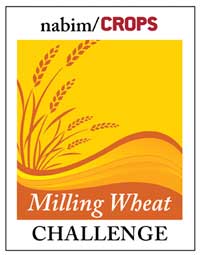Crops/nabim Milling Wheat Challenge: Yield handicap beaten

Barn-filling wheats struggle to live up to their name on the light to medium soils that David White, one of three finalists in the nabim/Crops Milling Wheat Challenge, farms in Cambridgeshire.
With an annual rainfall of just 560mm (22in) at Hawk Mill Farm, Little Wilbraham, yield is capped at 9-10t/ha.
As such, Mr White has switched his entire wheat area into milling varieties, knowing in most years he can secure enough premium to help overcome the yield handicap.
“Group 1 and 2 wheats yield just as well as Group 4s on this land,” he explains. “I just wasn’t getting the output with feed varieties, so it made sense to concentrate on quality.”
Mr White grows about 400ha of crops, including barley, rape and sugar beet. A third of the area is contract farmed.
About 260ha is down to milling wheats, mainly Solstice. “It suits the land and we know how to grow it, but it’s becoming increasingly risky relying on this one variety.”
Two 6ha blocks of Gallant and Panorama are being trialled, and he also hosts NIAB TAG trials, which give a useful insight into how new varieties might perform commercially.
David White Hawk Mill Farm • Total area – 400ha • Soil type – Fine sandy loam over chalk; some black fen • Varieties: Solstice – 227ha Gallant – 6ha Panorama – 6ha • Average five-year yield – 10.5t/ha (first wheat); 9t/ha (second wheat) |
 |
Meeting milling specification is rarely a problem – yields on the mainly fine sandy loams are not high enough to dilute protein levels and Hagbergs are rarely threatened by heavy rain. The farm’s New Holland CX880 combine also has ample capacity to help ensure wheat is cut at its peak.
Most fields are ploughed and pressed, run over with a Rexius press to consolidate further and allowed to green before being sprayed off then drilled with a 4m Vaderstad Rapid.
As well as providing a good seed-bed, this approach also helps control increasingly stubborn blackgrass. After sugar beet, most of which is lifted by mid-October, a pass with a Shakaerator followed by the drill is usually enough.
Phosphorous, potash and magnesium are applied at variable rates using SOYL’s nutrient management service. Variable rate nitrogen applications will be trialled next season.
Seed rates of 250/sq m are used when the drilling campaign kicks off about 20 September – the aim is to allow for Solstice’s shy tillering habit while avoiding an over-thick stand.
First wheats are Deter-dressed, second wheats get Latitude too. “Take-all used to be quite a problem, but this technology has allowed me to drill second wheats at the end of September without suffering a big yield penalty.”
Rates are increased to around 300 seeds/sq m behind sugar beet. “It’s often very dry – we deliver most of the moisture to the factory,” says Mr White.
Frontier’s Bob Mills looks after the agronomy. “We get a fantastic service and it’s good value.” A Bateman RB25 sprayer with a 3000 litre tank feeding 24m booms ensures sprays are applied when they are needed, including a robust T3 treatment of 0.75 litres of Prosaro (tebuconazole + prothioconazole).
“An ear spray is a given on this farm – we can’t risk fusarium and there’s a long time between ear emergence and harvest,” says Mr White.
Fine tuning of foliar nitrogen has been trialled using ADAS’s protein prediction scheme in conjunction with Camgrain.
For the past three years whole crop samples have been taken at three stages between ear emergence and harvest to produce a programme that will predict the amount of extra foliar nitrogen needed, if any, to ensure the crop hits the 13% target, taking into account several factors including rainfall, yield and the cost of nitrogen.
“It will be a very useful tool – we can’t afford to be throwing nitrogen around willy nilly.”
He sells about a quarter of the crop through local merchants, usually securing a feed base price and negotiating a premium afterwards. A further quarter is entered into Camgrain’s pre-Christmas on-farm pool – the aim is to empty the barns by the end of the year to reduce the risk of storage problems.
The other 50% is sent to Camgrain within 24 hours of cutting. “Overall, Camgrain delivers a good price, with premiums averaging about £20/t over the past five years,” says Mr White.
“And, because the grain sent to store is blended to match buyers’ requirements, I can gear my inputs to achieving the 13%/250/76 spec rather than having to aim slightly higher as insurance.
“Having access to central storage is key to the future – it is becoming the preferred source of ingredients for mills,” says Mr White. “It enables a consistent supply of vendor-assured deliveries – and that has to be the way ahead.”
THE JUDGES
 |
 |
 |
|---|---|---|
Martin Savage, trade policy manager, nabim. |
Mark Ireland, Lincolnshire farmer and Farmers Weekly Arable Farmer of the Year 2005. |
Robert Harris, freelance agricultural journalist |

